La Trobe University IBU5COV: Apple's Entrepreneurial Assessment
VerifiedAdded on 2023/06/13
|16
|3520
|274
Report
AI Summary
This report provides an entrepreneurial health assessment of Apple Inc., conducted as part of the IBU5COV Corporate Venturing course at La Trobe University. The assessment utilizes a qualitative research approach, drawing on both internal and external secondary data sources to evaluate Apple's entrepreneurial intensity and corporate entrepreneurial climate. The theoretical framework is based on four innovation categories: imitation, continuous, dynamically continuous, and discontinuous innovations. The analysis reveals that Apple has embraced new innovations and technologies across its processes, services, and products. Key aspects examined include the frequency and degree of entrepreneurship, assessed through innovativeness, proactiveness, and risk-taking, as well as Apple's organizational culture and structure. The report concludes by emphasizing the importance of entrepreneurial health assessments for organizations and encourages further research, highlighting the benefits of understanding and nurturing corporate entrepreneurship. Desklib offers a wealth of similar assignments and past papers for students seeking additional resources.
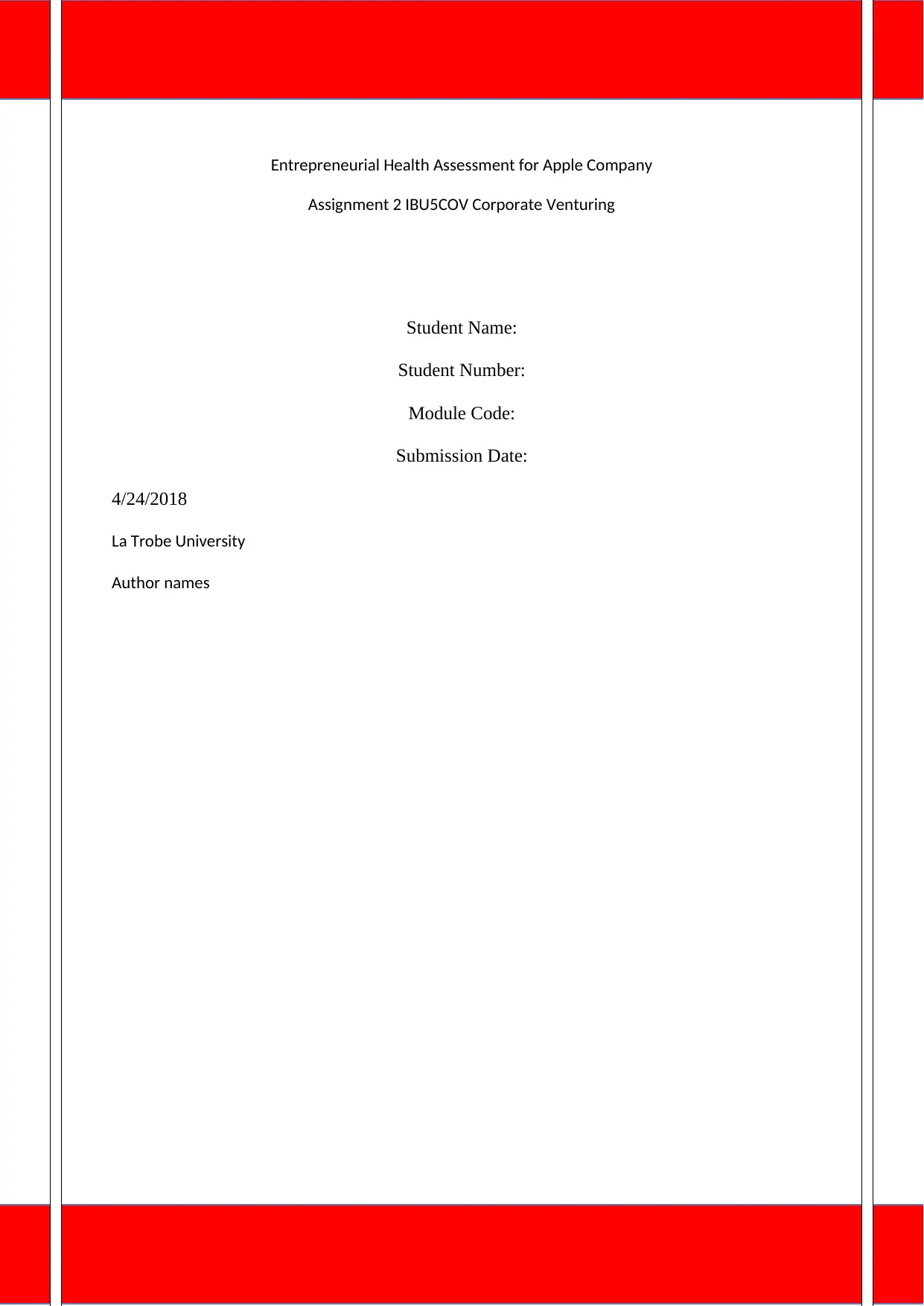
Entrepreneurial Health Assessment for Apple Company
Assignment 2 IBU5COV Corporate Venturing
Student Name:
Student Number:
Module Code:
Submission Date:
4/24/2018
La Trobe University
Author names
0
Assignment 2 IBU5COV Corporate Venturing
Student Name:
Student Number:
Module Code:
Submission Date:
4/24/2018
La Trobe University
Author names
0
Paraphrase This Document
Need a fresh take? Get an instant paraphrase of this document with our AI Paraphraser

ENTREPRENEURIAL HEALTH 1
1. Executive Summary
The sole aim of this report was to assess the entrepreneurial health of Apple Inc. The study
was conducted using a qualitative research approach, where there secondary sources were
used in the data collection. The internal sources of data comprised the annual or the company
and periodicals. The external sources were also used to get the qualitative results, which
comprised the research studies performed by different industry experts, researchers, and
scientists. The two main elements of the assessments consist of the entrepreneurial intensity
and the climate of corporate entrepreneurship. The theoretical framework has been based on
the four main categories of innovations which include imitation, continuous, dynamically
continuous, and discontinuous innovations. The key findings were that Apple has embraced
new innovations and technologies in the development of its processes, services, and products.
In conclusion, conducting an assessment of entrepreneurial health of organizations is
important based on the benefits associated with it as discussed in the report.
1
1. Executive Summary
The sole aim of this report was to assess the entrepreneurial health of Apple Inc. The study
was conducted using a qualitative research approach, where there secondary sources were
used in the data collection. The internal sources of data comprised the annual or the company
and periodicals. The external sources were also used to get the qualitative results, which
comprised the research studies performed by different industry experts, researchers, and
scientists. The two main elements of the assessments consist of the entrepreneurial intensity
and the climate of corporate entrepreneurship. The theoretical framework has been based on
the four main categories of innovations which include imitation, continuous, dynamically
continuous, and discontinuous innovations. The key findings were that Apple has embraced
new innovations and technologies in the development of its processes, services, and products.
In conclusion, conducting an assessment of entrepreneurial health of organizations is
important based on the benefits associated with it as discussed in the report.
1
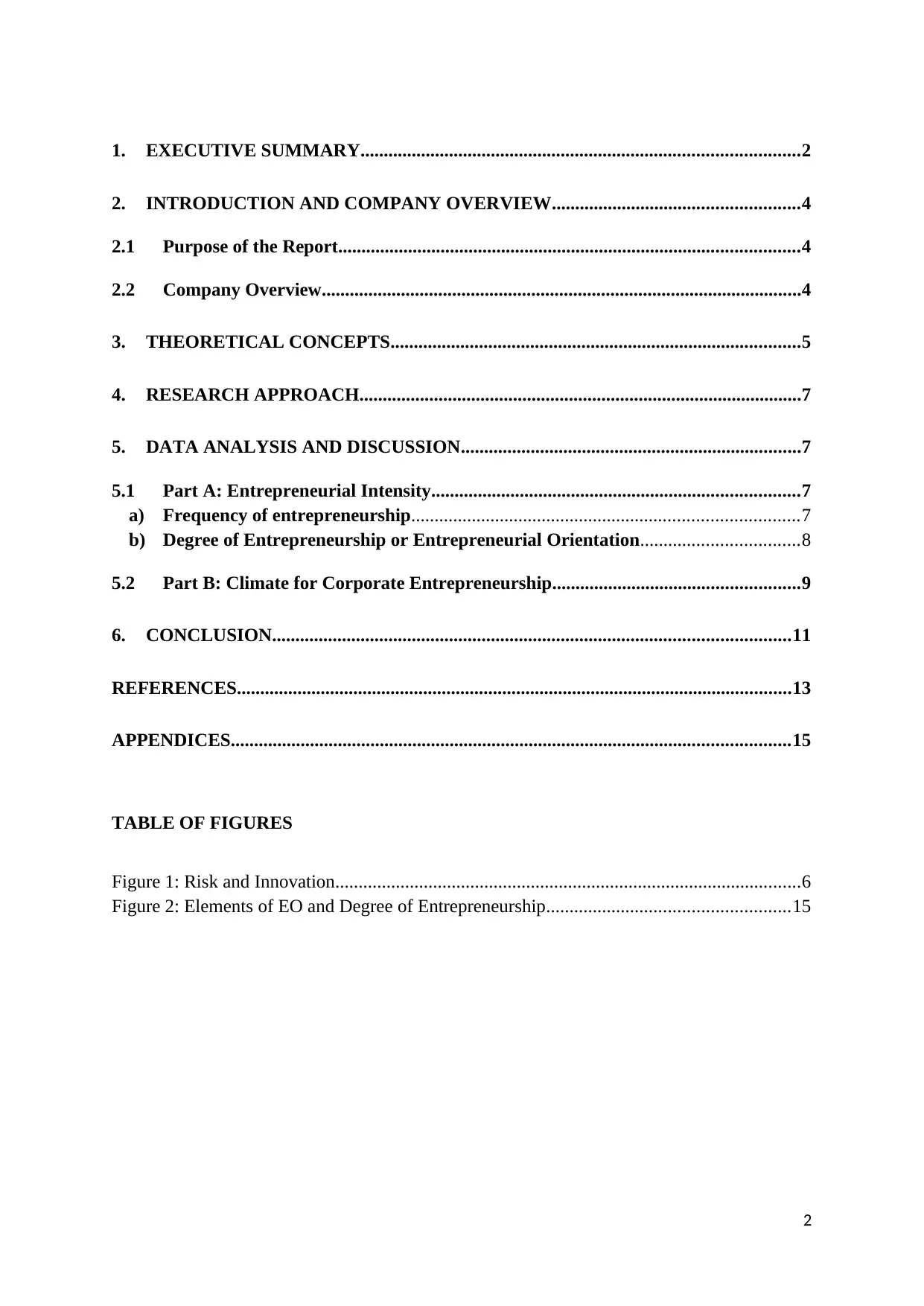
1. EXECUTIVE SUMMARY..............................................................................................2
2. INTRODUCTION AND COMPANY OVERVIEW.....................................................4
2.1 Purpose of the Report...................................................................................................4
2.2 Company Overview.......................................................................................................4
3. THEORETICAL CONCEPTS........................................................................................5
4. RESEARCH APPROACH...............................................................................................7
5. DATA ANALYSIS AND DISCUSSION.........................................................................7
5.1 Part A: Entrepreneurial Intensity...............................................................................7
a) Frequency of entrepreneurship...................................................................................7
b) Degree of Entrepreneurship or Entrepreneurial Orientation..................................8
5.2 Part B: Climate for Corporate Entrepreneurship.....................................................9
6. CONCLUSION...............................................................................................................11
REFERENCES.......................................................................................................................13
APPENDICES........................................................................................................................15
TABLE OF FIGURES
Figure 1: Risk and Innovation....................................................................................................6
Figure 2: Elements of EO and Degree of Entrepreneurship....................................................15
2
2. INTRODUCTION AND COMPANY OVERVIEW.....................................................4
2.1 Purpose of the Report...................................................................................................4
2.2 Company Overview.......................................................................................................4
3. THEORETICAL CONCEPTS........................................................................................5
4. RESEARCH APPROACH...............................................................................................7
5. DATA ANALYSIS AND DISCUSSION.........................................................................7
5.1 Part A: Entrepreneurial Intensity...............................................................................7
a) Frequency of entrepreneurship...................................................................................7
b) Degree of Entrepreneurship or Entrepreneurial Orientation..................................8
5.2 Part B: Climate for Corporate Entrepreneurship.....................................................9
6. CONCLUSION...............................................................................................................11
REFERENCES.......................................................................................................................13
APPENDICES........................................................................................................................15
TABLE OF FIGURES
Figure 1: Risk and Innovation....................................................................................................6
Figure 2: Elements of EO and Degree of Entrepreneurship....................................................15
2
⊘ This is a preview!⊘
Do you want full access?
Subscribe today to unlock all pages.

Trusted by 1+ million students worldwide
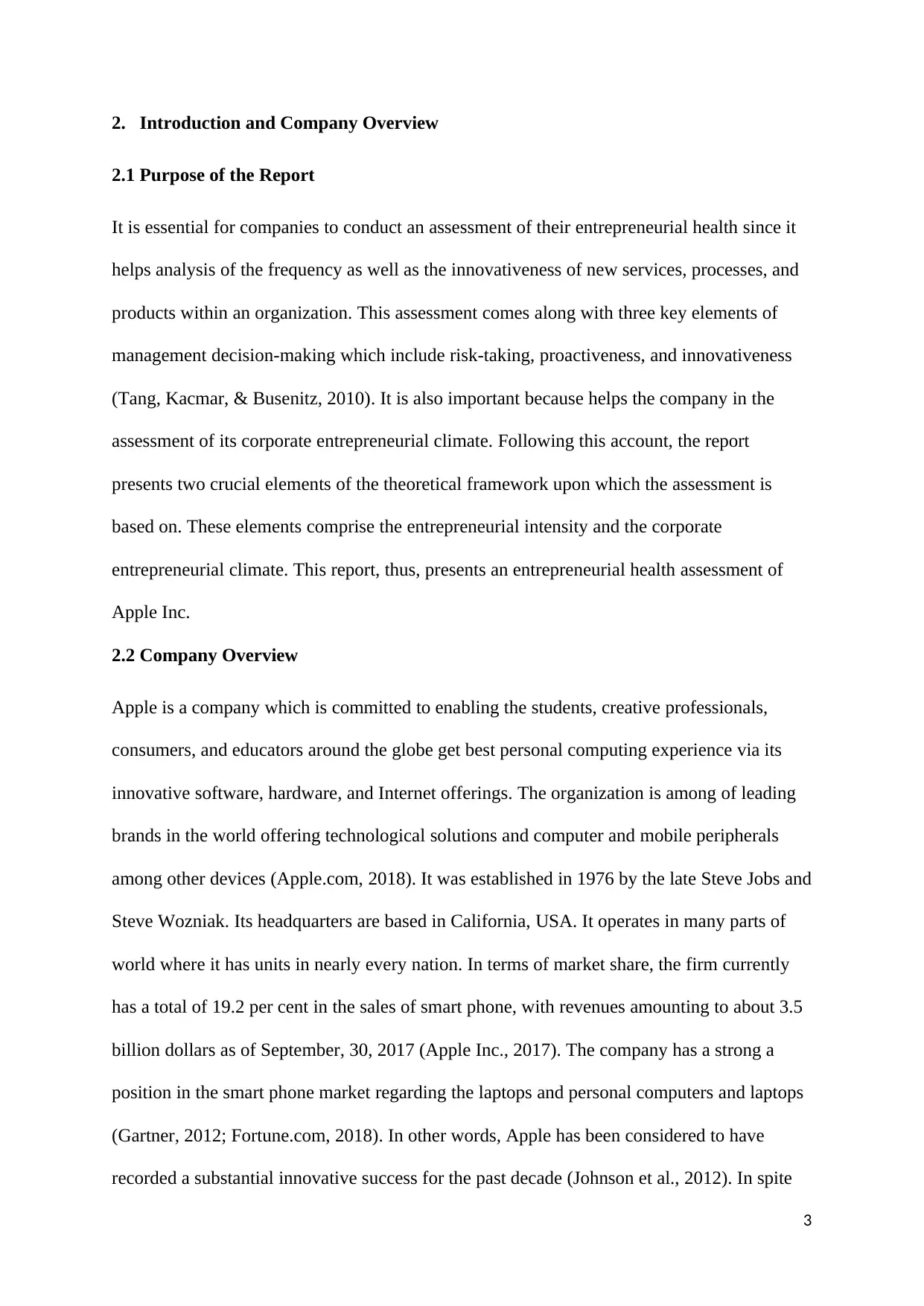
2. Introduction and Company Overview
2.1 Purpose of the Report
It is essential for companies to conduct an assessment of their entrepreneurial health since it
helps analysis of the frequency as well as the innovativeness of new services, processes, and
products within an organization. This assessment comes along with three key elements of
management decision-making which include risk-taking, proactiveness, and innovativeness
(Tang, Kacmar, & Busenitz, 2010). It is also important because helps the company in the
assessment of its corporate entrepreneurial climate. Following this account, the report
presents two crucial elements of the theoretical framework upon which the assessment is
based on. These elements comprise the entrepreneurial intensity and the corporate
entrepreneurial climate. This report, thus, presents an entrepreneurial health assessment of
Apple Inc.
2.2 Company Overview
Apple is a company which is committed to enabling the students, creative professionals,
consumers, and educators around the globe get best personal computing experience via its
innovative software, hardware, and Internet offerings. The organization is among of leading
brands in the world offering technological solutions and computer and mobile peripherals
among other devices (Apple.com, 2018). It was established in 1976 by the late Steve Jobs and
Steve Wozniak. Its headquarters are based in California, USA. It operates in many parts of
world where it has units in nearly every nation. In terms of market share, the firm currently
has a total of 19.2 per cent in the sales of smart phone, with revenues amounting to about 3.5
billion dollars as of September, 30, 2017 (Apple Inc., 2017). The company has a strong a
position in the smart phone market regarding the laptops and personal computers and laptops
(Gartner, 2012; Fortune.com, 2018). In other words, Apple has been considered to have
recorded a substantial innovative success for the past decade (Johnson et al., 2012). In spite
3
2.1 Purpose of the Report
It is essential for companies to conduct an assessment of their entrepreneurial health since it
helps analysis of the frequency as well as the innovativeness of new services, processes, and
products within an organization. This assessment comes along with three key elements of
management decision-making which include risk-taking, proactiveness, and innovativeness
(Tang, Kacmar, & Busenitz, 2010). It is also important because helps the company in the
assessment of its corporate entrepreneurial climate. Following this account, the report
presents two crucial elements of the theoretical framework upon which the assessment is
based on. These elements comprise the entrepreneurial intensity and the corporate
entrepreneurial climate. This report, thus, presents an entrepreneurial health assessment of
Apple Inc.
2.2 Company Overview
Apple is a company which is committed to enabling the students, creative professionals,
consumers, and educators around the globe get best personal computing experience via its
innovative software, hardware, and Internet offerings. The organization is among of leading
brands in the world offering technological solutions and computer and mobile peripherals
among other devices (Apple.com, 2018). It was established in 1976 by the late Steve Jobs and
Steve Wozniak. Its headquarters are based in California, USA. It operates in many parts of
world where it has units in nearly every nation. In terms of market share, the firm currently
has a total of 19.2 per cent in the sales of smart phone, with revenues amounting to about 3.5
billion dollars as of September, 30, 2017 (Apple Inc., 2017). The company has a strong a
position in the smart phone market regarding the laptops and personal computers and laptops
(Gartner, 2012; Fortune.com, 2018). In other words, Apple has been considered to have
recorded a substantial innovative success for the past decade (Johnson et al., 2012). In spite
3
Paraphrase This Document
Need a fresh take? Get an instant paraphrase of this document with our AI Paraphraser
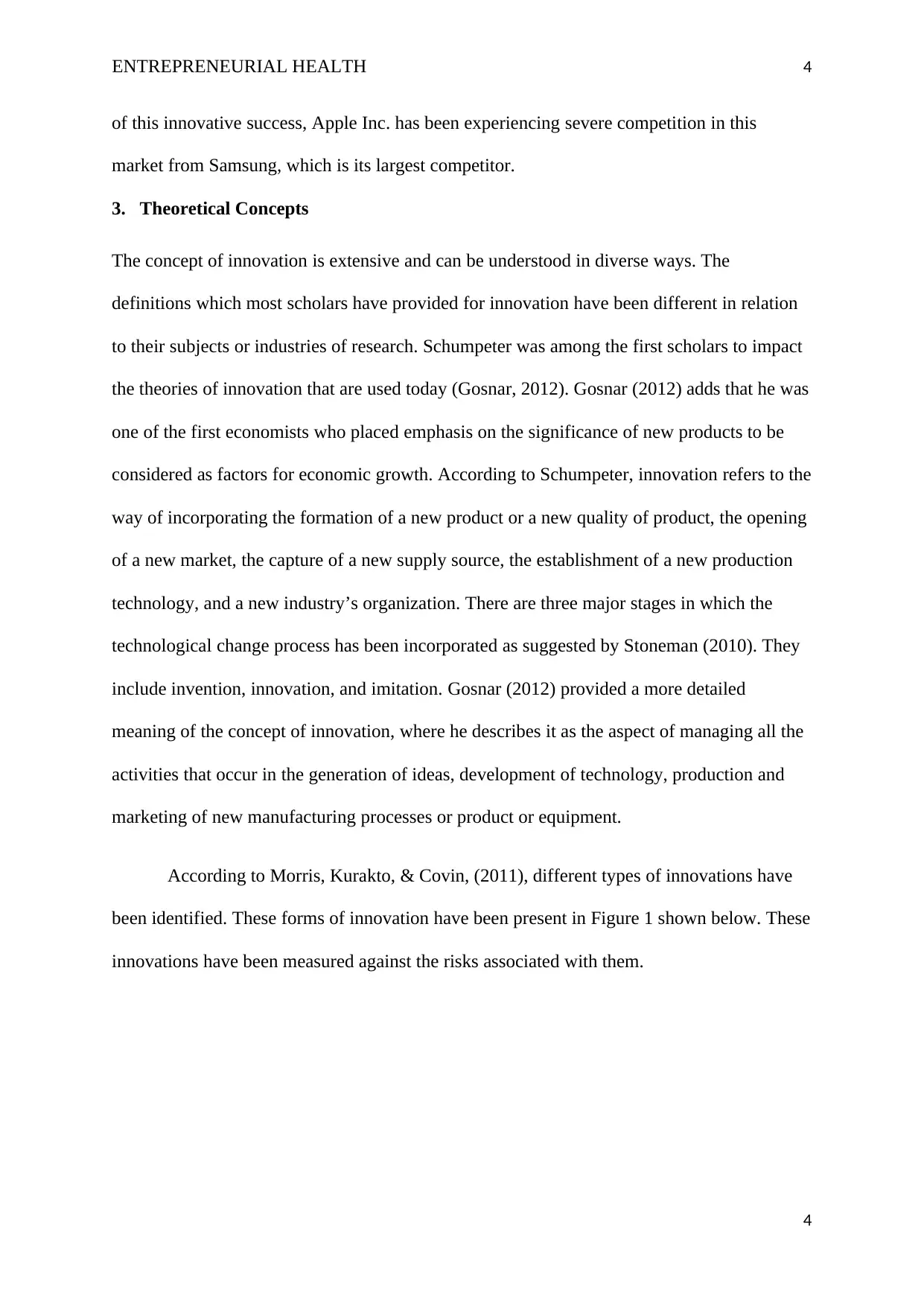
ENTREPRENEURIAL HEALTH 4
of this innovative success, Apple Inc. has been experiencing severe competition in this
market from Samsung, which is its largest competitor.
3. Theoretical Concepts
The concept of innovation is extensive and can be understood in diverse ways. The
definitions which most scholars have provided for innovation have been different in relation
to their subjects or industries of research. Schumpeter was among the first scholars to impact
the theories of innovation that are used today (Gosnar, 2012). Gosnar (2012) adds that he was
one of the first economists who placed emphasis on the significance of new products to be
considered as factors for economic growth. According to Schumpeter, innovation refers to the
way of incorporating the formation of a new product or a new quality of product, the opening
of a new market, the capture of a new supply source, the establishment of a new production
technology, and a new industry’s organization. There are three major stages in which the
technological change process has been incorporated as suggested by Stoneman (2010). They
include invention, innovation, and imitation. Gosnar (2012) provided a more detailed
meaning of the concept of innovation, where he describes it as the aspect of managing all the
activities that occur in the generation of ideas, development of technology, production and
marketing of new manufacturing processes or product or equipment.
According to Morris, Kurakto, & Covin, (2011), different types of innovations have
been identified. These forms of innovation have been present in Figure 1 shown below. These
innovations have been measured against the risks associated with them.
4
of this innovative success, Apple Inc. has been experiencing severe competition in this
market from Samsung, which is its largest competitor.
3. Theoretical Concepts
The concept of innovation is extensive and can be understood in diverse ways. The
definitions which most scholars have provided for innovation have been different in relation
to their subjects or industries of research. Schumpeter was among the first scholars to impact
the theories of innovation that are used today (Gosnar, 2012). Gosnar (2012) adds that he was
one of the first economists who placed emphasis on the significance of new products to be
considered as factors for economic growth. According to Schumpeter, innovation refers to the
way of incorporating the formation of a new product or a new quality of product, the opening
of a new market, the capture of a new supply source, the establishment of a new production
technology, and a new industry’s organization. There are three major stages in which the
technological change process has been incorporated as suggested by Stoneman (2010). They
include invention, innovation, and imitation. Gosnar (2012) provided a more detailed
meaning of the concept of innovation, where he describes it as the aspect of managing all the
activities that occur in the generation of ideas, development of technology, production and
marketing of new manufacturing processes or product or equipment.
According to Morris, Kurakto, & Covin, (2011), different types of innovations have
been identified. These forms of innovation have been present in Figure 1 shown below. These
innovations have been measured against the risks associated with them.
4

ENTREPRENEURIAL HEALTH 5
Figure 1: Risk and Innovation
(Source: Morris, Kuratko & Covin, 2011, p.69)
The author considers a continuous innovation as an extreme where an existing product goes
through marginal shifts without changing the habits of customer. In this case, is likely that the
customer may even fail to see such products as new, although the firm may have invested
huge amounts of money in the improvement of its existing products. This form of innovation
has lower risks as compared to imitation and discontinuous innovations. Dynamically
continuous innovation, on the other hand, occurs between the continuous innovation and
discontinuous. The risk of changes in the habits of the customers associated with this
innovation is not as big as in a discontinuous innovation and not as small as in a continuous
type of innovation. By their very nature, discontinuous innovations are discontinuous to every
segment of customers, because they are composed of only new-to-the-world products. Such
new products appear to be so fundamentally distinct from the products which already exist
and are useful in reshaping competition and markets. The risks of changing customer
behaviours are the highest in this kind of innovation. Imitation has been deemed to be a
stepping stone for making it possible for the companies from lagging nations to take part in
innovation (Konig, Lorenz, & Zilibotti, 2014). As noted from Figure 1, this type of
innovation has higher risks, just like the discontinuous innovation.
5
Figure 1: Risk and Innovation
(Source: Morris, Kuratko & Covin, 2011, p.69)
The author considers a continuous innovation as an extreme where an existing product goes
through marginal shifts without changing the habits of customer. In this case, is likely that the
customer may even fail to see such products as new, although the firm may have invested
huge amounts of money in the improvement of its existing products. This form of innovation
has lower risks as compared to imitation and discontinuous innovations. Dynamically
continuous innovation, on the other hand, occurs between the continuous innovation and
discontinuous. The risk of changes in the habits of the customers associated with this
innovation is not as big as in a discontinuous innovation and not as small as in a continuous
type of innovation. By their very nature, discontinuous innovations are discontinuous to every
segment of customers, because they are composed of only new-to-the-world products. Such
new products appear to be so fundamentally distinct from the products which already exist
and are useful in reshaping competition and markets. The risks of changing customer
behaviours are the highest in this kind of innovation. Imitation has been deemed to be a
stepping stone for making it possible for the companies from lagging nations to take part in
innovation (Konig, Lorenz, & Zilibotti, 2014). As noted from Figure 1, this type of
innovation has higher risks, just like the discontinuous innovation.
5
⊘ This is a preview!⊘
Do you want full access?
Subscribe today to unlock all pages.

Trusted by 1+ million students worldwide
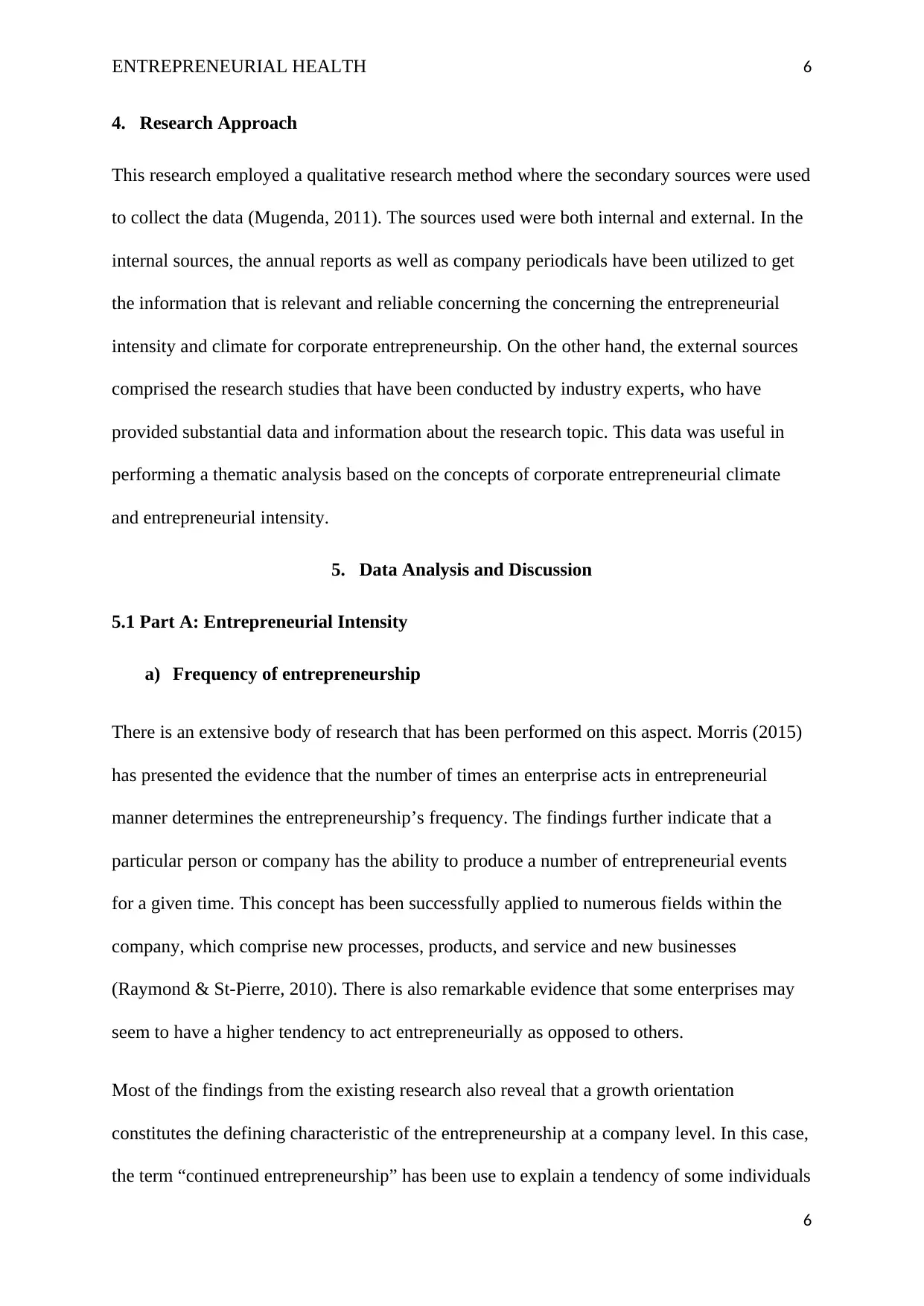
ENTREPRENEURIAL HEALTH 6
4. Research Approach
This research employed a qualitative research method where the secondary sources were used
to collect the data (Mugenda, 2011). The sources used were both internal and external. In the
internal sources, the annual reports as well as company periodicals have been utilized to get
the information that is relevant and reliable concerning the concerning the entrepreneurial
intensity and climate for corporate entrepreneurship. On the other hand, the external sources
comprised the research studies that have been conducted by industry experts, who have
provided substantial data and information about the research topic. This data was useful in
performing a thematic analysis based on the concepts of corporate entrepreneurial climate
and entrepreneurial intensity.
5. Data Analysis and Discussion
5.1 Part A: Entrepreneurial Intensity
a) Frequency of entrepreneurship
There is an extensive body of research that has been performed on this aspect. Morris (2015)
has presented the evidence that the number of times an enterprise acts in entrepreneurial
manner determines the entrepreneurship’s frequency. The findings further indicate that a
particular person or company has the ability to produce a number of entrepreneurial events
for a given time. This concept has been successfully applied to numerous fields within the
company, which comprise new processes, products, and service and new businesses
(Raymond & St-Pierre, 2010). There is also remarkable evidence that some enterprises may
seem to have a higher tendency to act entrepreneurially as opposed to others.
Most of the findings from the existing research also reveal that a growth orientation
constitutes the defining characteristic of the entrepreneurship at a company level. In this case,
the term “continued entrepreneurship” has been use to explain a tendency of some individuals
6
4. Research Approach
This research employed a qualitative research method where the secondary sources were used
to collect the data (Mugenda, 2011). The sources used were both internal and external. In the
internal sources, the annual reports as well as company periodicals have been utilized to get
the information that is relevant and reliable concerning the concerning the entrepreneurial
intensity and climate for corporate entrepreneurship. On the other hand, the external sources
comprised the research studies that have been conducted by industry experts, who have
provided substantial data and information about the research topic. This data was useful in
performing a thematic analysis based on the concepts of corporate entrepreneurial climate
and entrepreneurial intensity.
5. Data Analysis and Discussion
5.1 Part A: Entrepreneurial Intensity
a) Frequency of entrepreneurship
There is an extensive body of research that has been performed on this aspect. Morris (2015)
has presented the evidence that the number of times an enterprise acts in entrepreneurial
manner determines the entrepreneurship’s frequency. The findings further indicate that a
particular person or company has the ability to produce a number of entrepreneurial events
for a given time. This concept has been successfully applied to numerous fields within the
company, which comprise new processes, products, and service and new businesses
(Raymond & St-Pierre, 2010). There is also remarkable evidence that some enterprises may
seem to have a higher tendency to act entrepreneurially as opposed to others.
Most of the findings from the existing research also reveal that a growth orientation
constitutes the defining characteristic of the entrepreneurship at a company level. In this case,
the term “continued entrepreneurship” has been use to explain a tendency of some individuals
6
Paraphrase This Document
Need a fresh take? Get an instant paraphrase of this document with our AI Paraphraser

ENTREPRENEURIAL HEALTH 7
and enterprises being more entrepreneurial as opposed to others in terms of looking for novel
business opportunities continuously (Vaghely & Julien, 2010). There is also another finding
that a firm is deemed entrepreneurial if it can develop a “higher than average number of new
products or new markets within that industry” (Morris, 2015). Therefore, the company which
produces a single entrepreneurial business, like a “spin-off” from their business that is in
existence over a long period, does not occur as a particularly entrepreneurial enterprise.
Additionally, it has been noted that there is a continued effort in the development of new
processes, services, products, and markets among others indicates an enterprise that is highly
entrepreneurial. Morris (2015) concludes that the entrepreneurship’s frequency is relative and
seems to be varied for a certain period and over the enterprise’s life-cycle.
b) Degree of Entrepreneurship or Entrepreneurial Orientation
This aspect has been assessed on the basis of sub-dimensions which include innovativeness,
proactiveness, and risk-taking. The concept of innovativeness has been defined as the
tendency to develop new services, products and technologies, which include adaptations to
the technologies, products, and services that are in existence. The sub-dimension of
proactiveness relates to an enterprise’s managerial orientation to seek opportunities and
comprises competitive aggressiveness, boldness, and initiative. The concept of risk-taking, on
the other hand, implies being willing to commit substantial resources to the opportunities
which may not work, while being careful to reduce uncertainties, to ensure that risks are not
only calculated but also manageable (Vaghely & Julien, 2010). It is worth to note that the
literature from different studies have supported the existence of these three sub-dimensions as
a measure of the company’s degree of entrepreneurship. A summary of these sub-dimensions
has been presented in Appendix A.
7
and enterprises being more entrepreneurial as opposed to others in terms of looking for novel
business opportunities continuously (Vaghely & Julien, 2010). There is also another finding
that a firm is deemed entrepreneurial if it can develop a “higher than average number of new
products or new markets within that industry” (Morris, 2015). Therefore, the company which
produces a single entrepreneurial business, like a “spin-off” from their business that is in
existence over a long period, does not occur as a particularly entrepreneurial enterprise.
Additionally, it has been noted that there is a continued effort in the development of new
processes, services, products, and markets among others indicates an enterprise that is highly
entrepreneurial. Morris (2015) concludes that the entrepreneurship’s frequency is relative and
seems to be varied for a certain period and over the enterprise’s life-cycle.
b) Degree of Entrepreneurship or Entrepreneurial Orientation
This aspect has been assessed on the basis of sub-dimensions which include innovativeness,
proactiveness, and risk-taking. The concept of innovativeness has been defined as the
tendency to develop new services, products and technologies, which include adaptations to
the technologies, products, and services that are in existence. The sub-dimension of
proactiveness relates to an enterprise’s managerial orientation to seek opportunities and
comprises competitive aggressiveness, boldness, and initiative. The concept of risk-taking, on
the other hand, implies being willing to commit substantial resources to the opportunities
which may not work, while being careful to reduce uncertainties, to ensure that risks are not
only calculated but also manageable (Vaghely & Julien, 2010). It is worth to note that the
literature from different studies have supported the existence of these three sub-dimensions as
a measure of the company’s degree of entrepreneurship. A summary of these sub-dimensions
has been presented in Appendix A.
7
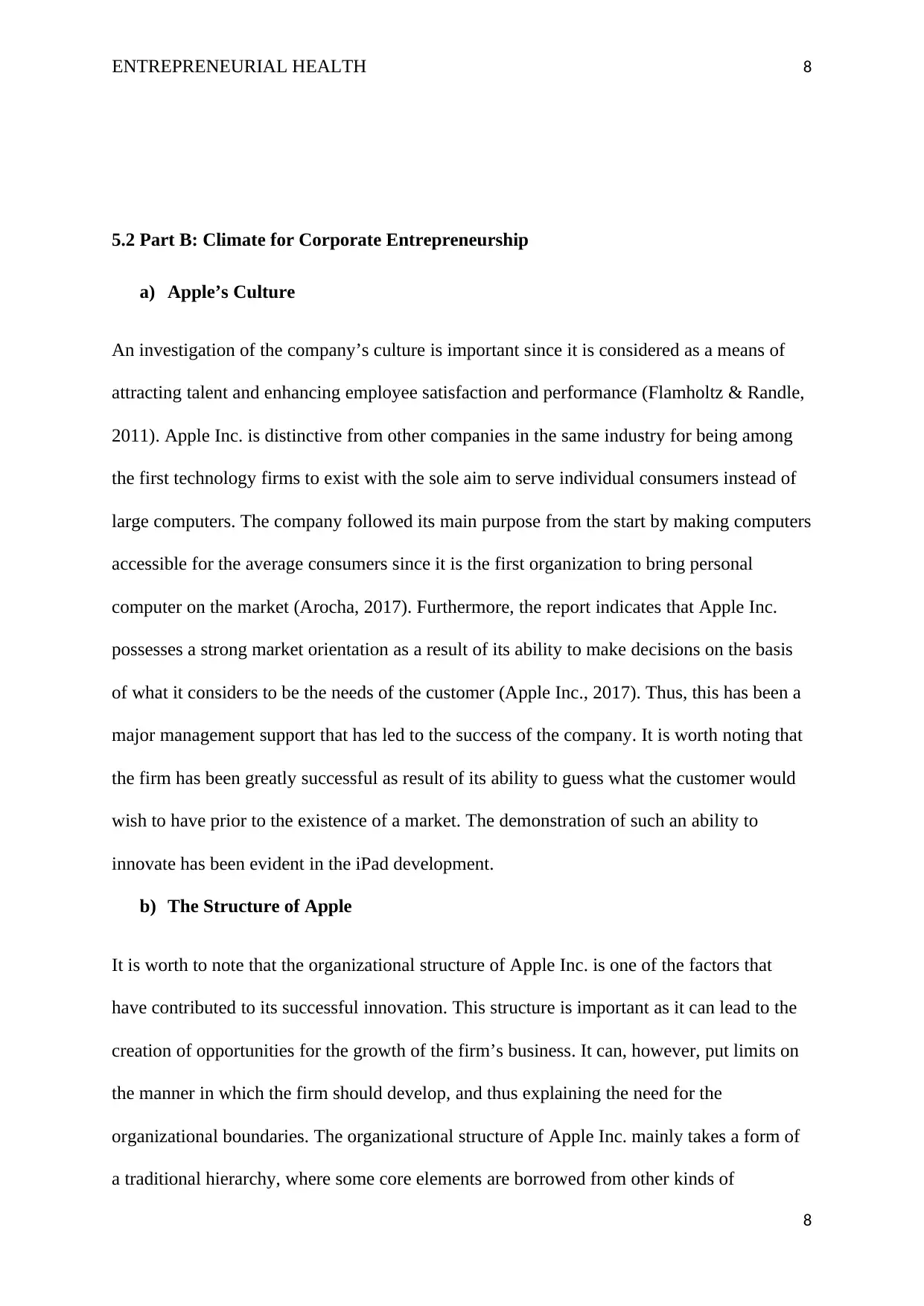
ENTREPRENEURIAL HEALTH 8
5.2 Part B: Climate for Corporate Entrepreneurship
a) Apple’s Culture
An investigation of the company’s culture is important since it is considered as a means of
attracting talent and enhancing employee satisfaction and performance (Flamholtz & Randle,
2011). Apple Inc. is distinctive from other companies in the same industry for being among
the first technology firms to exist with the sole aim to serve individual consumers instead of
large computers. The company followed its main purpose from the start by making computers
accessible for the average consumers since it is the first organization to bring personal
computer on the market (Arocha, 2017). Furthermore, the report indicates that Apple Inc.
possesses a strong market orientation as a result of its ability to make decisions on the basis
of what it considers to be the needs of the customer (Apple Inc., 2017). Thus, this has been a
major management support that has led to the success of the company. It is worth noting that
the firm has been greatly successful as result of its ability to guess what the customer would
wish to have prior to the existence of a market. The demonstration of such an ability to
innovate has been evident in the iPad development.
b) The Structure of Apple
It is worth to note that the organizational structure of Apple Inc. is one of the factors that
have contributed to its successful innovation. This structure is important as it can lead to the
creation of opportunities for the growth of the firm’s business. It can, however, put limits on
the manner in which the firm should develop, and thus explaining the need for the
organizational boundaries. The organizational structure of Apple Inc. mainly takes a form of
a traditional hierarchy, where some core elements are borrowed from other kinds of
8
5.2 Part B: Climate for Corporate Entrepreneurship
a) Apple’s Culture
An investigation of the company’s culture is important since it is considered as a means of
attracting talent and enhancing employee satisfaction and performance (Flamholtz & Randle,
2011). Apple Inc. is distinctive from other companies in the same industry for being among
the first technology firms to exist with the sole aim to serve individual consumers instead of
large computers. The company followed its main purpose from the start by making computers
accessible for the average consumers since it is the first organization to bring personal
computer on the market (Arocha, 2017). Furthermore, the report indicates that Apple Inc.
possesses a strong market orientation as a result of its ability to make decisions on the basis
of what it considers to be the needs of the customer (Apple Inc., 2017). Thus, this has been a
major management support that has led to the success of the company. It is worth noting that
the firm has been greatly successful as result of its ability to guess what the customer would
wish to have prior to the existence of a market. The demonstration of such an ability to
innovate has been evident in the iPad development.
b) The Structure of Apple
It is worth to note that the organizational structure of Apple Inc. is one of the factors that
have contributed to its successful innovation. This structure is important as it can lead to the
creation of opportunities for the growth of the firm’s business. It can, however, put limits on
the manner in which the firm should develop, and thus explaining the need for the
organizational boundaries. The organizational structure of Apple Inc. mainly takes a form of
a traditional hierarchy, where some core elements are borrowed from other kinds of
8
⊘ This is a preview!⊘
Do you want full access?
Subscribe today to unlock all pages.

Trusted by 1+ million students worldwide
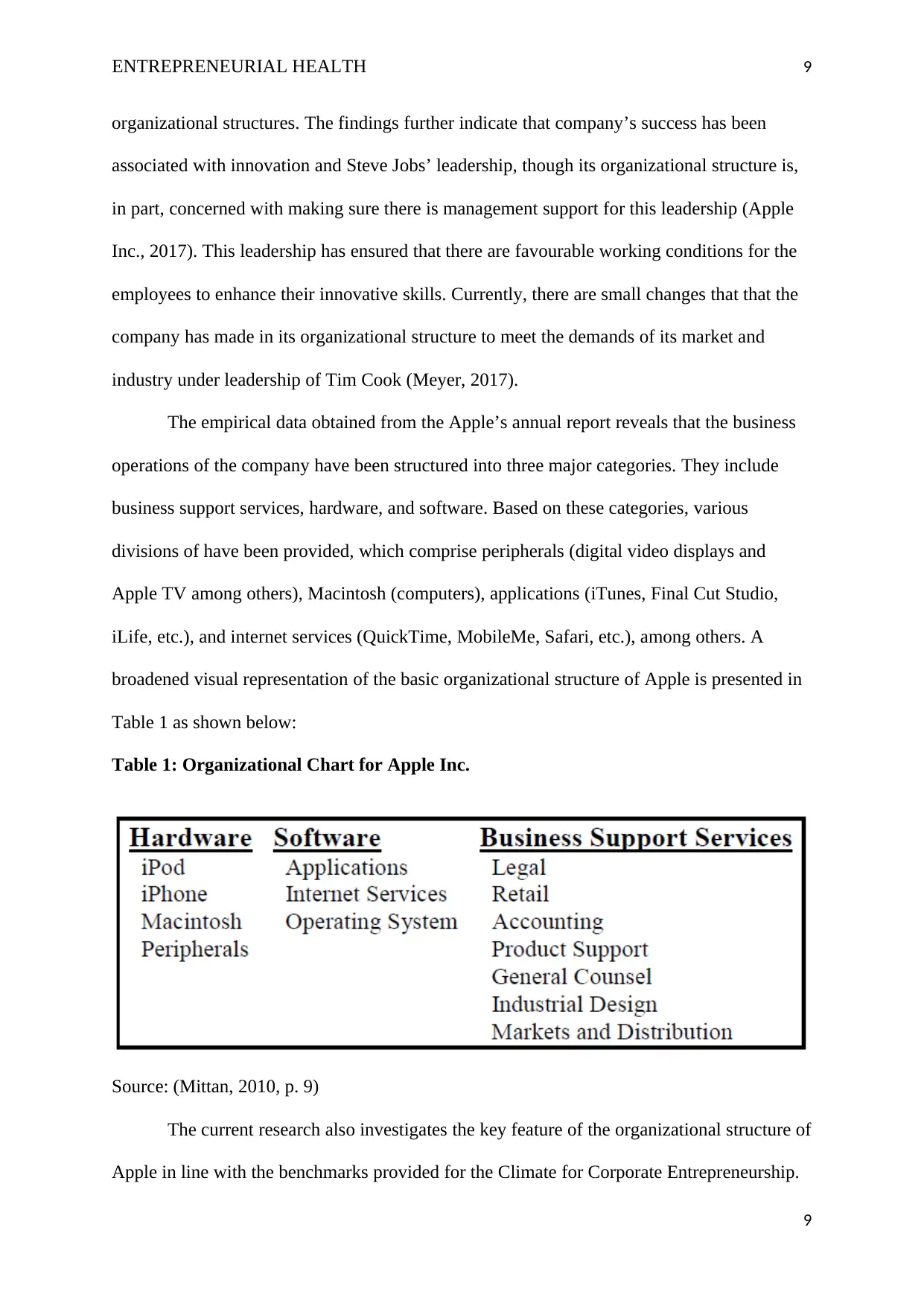
ENTREPRENEURIAL HEALTH 9
organizational structures. The findings further indicate that company’s success has been
associated with innovation and Steve Jobs’ leadership, though its organizational structure is,
in part, concerned with making sure there is management support for this leadership (Apple
Inc., 2017). This leadership has ensured that there are favourable working conditions for the
employees to enhance their innovative skills. Currently, there are small changes that that the
company has made in its organizational structure to meet the demands of its market and
industry under leadership of Tim Cook (Meyer, 2017).
The empirical data obtained from the Apple’s annual report reveals that the business
operations of the company have been structured into three major categories. They include
business support services, hardware, and software. Based on these categories, various
divisions of have been provided, which comprise peripherals (digital video displays and
Apple TV among others), Macintosh (computers), applications (iTunes, Final Cut Studio,
iLife, etc.), and internet services (QuickTime, MobileMe, Safari, etc.), among others. A
broadened visual representation of the basic organizational structure of Apple is presented in
Table 1 as shown below:
Table 1: Organizational Chart for Apple Inc.
Source: (Mittan, 2010, p. 9)
The current research also investigates the key feature of the organizational structure of
Apple in line with the benchmarks provided for the Climate for Corporate Entrepreneurship.
9
organizational structures. The findings further indicate that company’s success has been
associated with innovation and Steve Jobs’ leadership, though its organizational structure is,
in part, concerned with making sure there is management support for this leadership (Apple
Inc., 2017). This leadership has ensured that there are favourable working conditions for the
employees to enhance their innovative skills. Currently, there are small changes that that the
company has made in its organizational structure to meet the demands of its market and
industry under leadership of Tim Cook (Meyer, 2017).
The empirical data obtained from the Apple’s annual report reveals that the business
operations of the company have been structured into three major categories. They include
business support services, hardware, and software. Based on these categories, various
divisions of have been provided, which comprise peripherals (digital video displays and
Apple TV among others), Macintosh (computers), applications (iTunes, Final Cut Studio,
iLife, etc.), and internet services (QuickTime, MobileMe, Safari, etc.), among others. A
broadened visual representation of the basic organizational structure of Apple is presented in
Table 1 as shown below:
Table 1: Organizational Chart for Apple Inc.
Source: (Mittan, 2010, p. 9)
The current research also investigates the key feature of the organizational structure of
Apple in line with the benchmarks provided for the Climate for Corporate Entrepreneurship.
9
Paraphrase This Document
Need a fresh take? Get an instant paraphrase of this document with our AI Paraphraser

ENTREPRENEURIAL HEALTH 10
The research continues to hold that the organizational structure of the company has made it
possible for Apple to keep innovating at a faster rate, within the time that is available for
them. The evidence from the existing research points out three core characteristics of the
organizational structure of Apple Inc. They encompass function-based grouping, product-
based category, and spoke-and- wheel hierarchy.
In the context of the function-based grouping, the upper tier of the organizational
structure of Apple has this characteristic. It is an element obtained from the functional form
of organizational structure. In this case, senior vice president takes care of a business
function, and reports to Tim Cook (Meyer 2017). On the other hand, the lower tier of
organizational structure of the firm is characterized by product-based grouping, constituting
an element that is obtained from the divisional kind of organizational structure. It occurs
below the senior vice presidents, where there are numerous vice presidents for different
products or outputs. Finally, Spoke- and –Wheel Hierarchy, everything goes to the senior
office. Today, things have changed where there is more collaboration among different parts
of the firm, like hardware teams and software teams. It has been noted that the vice presidents
of Apple possess more autonomy, under the leadership of Cook (Meyer, 2017). Therefore,
the current organizational structure of the firm is less stiff, though it still has elements of a
spoke-and-wheel hierarchy where its central person is Tim Cook.
6. Conclusion
The conclusion of this report can be that it is important for organizations to conduct an
assessment of their entrepreneurial health. Through this assessment, the report has assessed
the frequency as well as the innovativeness of new services, processes, and products within
Apple Inc. The climate of the corporate entrepreneurship has also been assessed. In this case,
the report has assesses how well the culture as well as the organizational structure of Apple
Inc. has supported innovation and entrepreneurship. The key factors of concern have been the
10
The research continues to hold that the organizational structure of the company has made it
possible for Apple to keep innovating at a faster rate, within the time that is available for
them. The evidence from the existing research points out three core characteristics of the
organizational structure of Apple Inc. They encompass function-based grouping, product-
based category, and spoke-and- wheel hierarchy.
In the context of the function-based grouping, the upper tier of the organizational
structure of Apple has this characteristic. It is an element obtained from the functional form
of organizational structure. In this case, senior vice president takes care of a business
function, and reports to Tim Cook (Meyer 2017). On the other hand, the lower tier of
organizational structure of the firm is characterized by product-based grouping, constituting
an element that is obtained from the divisional kind of organizational structure. It occurs
below the senior vice presidents, where there are numerous vice presidents for different
products or outputs. Finally, Spoke- and –Wheel Hierarchy, everything goes to the senior
office. Today, things have changed where there is more collaboration among different parts
of the firm, like hardware teams and software teams. It has been noted that the vice presidents
of Apple possess more autonomy, under the leadership of Cook (Meyer, 2017). Therefore,
the current organizational structure of the firm is less stiff, though it still has elements of a
spoke-and-wheel hierarchy where its central person is Tim Cook.
6. Conclusion
The conclusion of this report can be that it is important for organizations to conduct an
assessment of their entrepreneurial health. Through this assessment, the report has assessed
the frequency as well as the innovativeness of new services, processes, and products within
Apple Inc. The climate of the corporate entrepreneurship has also been assessed. In this case,
the report has assesses how well the culture as well as the organizational structure of Apple
Inc. has supported innovation and entrepreneurship. The key factors of concern have been the
10

ENTREPRENEURIAL HEALTH 11
management support; work discretion; rewards or reinforcement; time availability; and
organizational boundaries and other specific climate variables.
11
management support; work discretion; rewards or reinforcement; time availability; and
organizational boundaries and other specific climate variables.
11
⊘ This is a preview!⊘
Do you want full access?
Subscribe today to unlock all pages.

Trusted by 1+ million students worldwide
1 out of 16
Related Documents
Your All-in-One AI-Powered Toolkit for Academic Success.
+13062052269
info@desklib.com
Available 24*7 on WhatsApp / Email
![[object Object]](/_next/static/media/star-bottom.7253800d.svg)
Unlock your academic potential
Copyright © 2020–2026 A2Z Services. All Rights Reserved. Developed and managed by ZUCOL.





